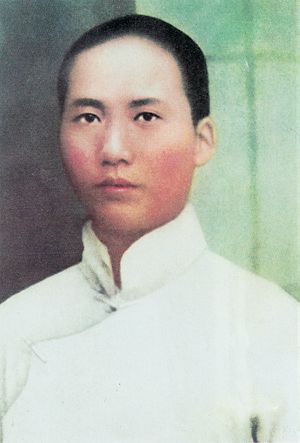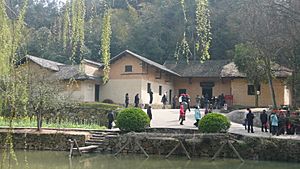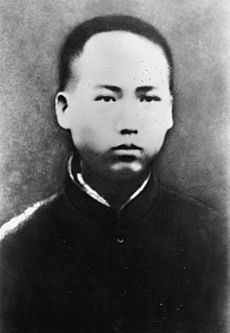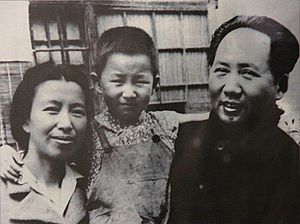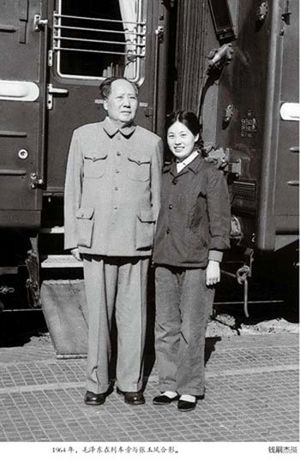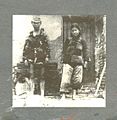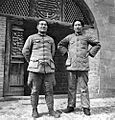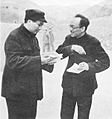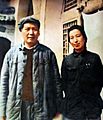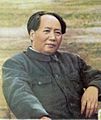Mao Zedong facts for kids
Quick facts for kids
Mao Zedong
|
|||||||||||||||||||||||||||||||||
|---|---|---|---|---|---|---|---|---|---|---|---|---|---|---|---|---|---|---|---|---|---|---|---|---|---|---|---|---|---|---|---|---|---|
| 毛泽东 | |||||||||||||||||||||||||||||||||
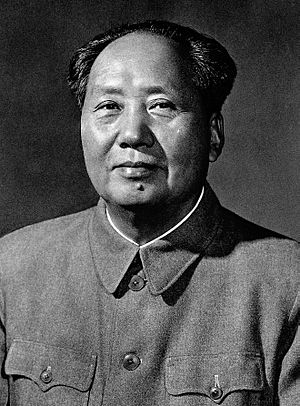
Official portrait, 1959
|
|||||||||||||||||||||||||||||||||
| Chairman of the Communist Party of China | |||||||||||||||||||||||||||||||||
| In office 20 March 1943 – 9 September 1976 |
|||||||||||||||||||||||||||||||||
| Deputy | Liu Shaoqi Lin Biao Zhou Enlai Hua Guofeng |
||||||||||||||||||||||||||||||||
| Preceded by | Zhang Wentian (as General Secretary) | ||||||||||||||||||||||||||||||||
| Succeeded by | Hua Guofeng | ||||||||||||||||||||||||||||||||
| 1st Chairman of the People's Republic of China | |||||||||||||||||||||||||||||||||
| In office 27 September 1954 – 27 April 1959 |
|||||||||||||||||||||||||||||||||
| Premier | Zhou Enlai | ||||||||||||||||||||||||||||||||
| Deputy | Zhu De | ||||||||||||||||||||||||||||||||
| Succeeded by | Liu Shaoqi | ||||||||||||||||||||||||||||||||
| Chairman of the Central Military Commission | |||||||||||||||||||||||||||||||||
| In office 8 September 1954 – 9 September 1976 |
|||||||||||||||||||||||||||||||||
| Deputy | Zhu De Lin Biao Ye Jianying |
||||||||||||||||||||||||||||||||
| Succeeded by | Hua Guofeng | ||||||||||||||||||||||||||||||||
| Chairman of the Central People's Government | |||||||||||||||||||||||||||||||||
| In office 1 October 1949 – 27 September 1954 |
|||||||||||||||||||||||||||||||||
| Premier | Zhou Enlai | ||||||||||||||||||||||||||||||||
| Personal details | |||||||||||||||||||||||||||||||||
| Born | 26 December 1893 Shaoshan, Hunan, Qing dynasty |
||||||||||||||||||||||||||||||||
| Died | 9 September 1976 (aged 82) Beijing, People's Republic of China |
||||||||||||||||||||||||||||||||
| Resting place | Chairman Mao Memorial Hall, Beijing | ||||||||||||||||||||||||||||||||
| Political party | Communist Party of China (1921–1976) | ||||||||||||||||||||||||||||||||
| Other political affiliations |
Kuomintang (1925–1926) | ||||||||||||||||||||||||||||||||
| Spouses |
|
||||||||||||||||||||||||||||||||
| Children | 10, including: Mao Anying Mao Anqing Mao Anlong Yang Yuehua Li Min Li Na |
||||||||||||||||||||||||||||||||
| Parents |
|
||||||||||||||||||||||||||||||||
| Alma mater | Hunan First Normal University | ||||||||||||||||||||||||||||||||
| Signature | |||||||||||||||||||||||||||||||||
| Chinese name | |||||||||||||||||||||||||||||||||
| Simplified Chinese | 毛泽东 | ||||||||||||||||||||||||||||||||
| Traditional Chinese | 毛澤東 | ||||||||||||||||||||||||||||||||
|
|||||||||||||||||||||||||||||||||
| Courtesy name | |||||||||||||||||||||||||||||||||
| Simplified Chinese | 润之 | ||||||||||||||||||||||||||||||||
| Traditional Chinese | 潤之 | ||||||||||||||||||||||||||||||||
|
|||||||||||||||||||||||||||||||||
|
Central institution membership
1964–1976: Member, National People's Congress
1954–1959: Member, National People's Congress 1938–1976: Member, 6th, 7th, 8th, 9th, 10th Politburo 1938–1976: Member, 6th, 7th, 8th, 9th, 10th Central Committee Other offices held
1954–1959: Chairman of the People's Republic of China
1954–1976: Chairman, CPC Central Military Commission 1954–1959: President and Chairman, National Defence Council 1954–1976: Honorary Chairman, CPPCC National Committee 1949–1954: Chairman, Central People's Revolutionary Military Commission 1949–1954: Chairman, CPPCC National Committee 1949–1954: Chairman, PRC Central People's Government 1943–1956: Chairman, CPC Central Secretariat 1936–1949: Chairman, CPC Central Military Commission |
|||||||||||||||||||||||||||||||||
Mao Zedong (26 December 1893 – 9 September 1976), also known as Chairman Mao, was a Chinese politician, political theorist, military strategist, poet, and communist revolutionary who was the founder of the People's Republic of China (PRC). He was the chairman of the Chinese Communist Party from the establishment of the PRC in 1949 until his death in 1976. His theories, military strategies, and political policies are collectively known as Maoism.
Contents
Early life and education
Mao Zedong was born on 26 December 1893, in Shaoshan village, Hunan. His father, Mao Yichang, was a formerly impoverished peasant who had become one of the wealthiest farmers in Shaoshan.
His father was very strict and would beat him and his three siblings, the boys Zemin and Zetan, as well as an adopted girl, Zejian. At age 8, Mao was sent to Shaoshan Primary School where he learned the value systems of Confucianism. He later admitted that he did not enjoy the classical Chinese texts preaching Confucian morals. Instead, he liked reading classic novels like Romance of the Three Kingdoms and Water Margin.
At age 13, Mao finished primary education, and his father arranged him to marry to the 17-year-old Luo Yixiu. Mao refused to recognise her as his wife and moved away. Luo was disgraced and died in 1910 at 21 years old.
At age 16, Mao moved to a higher primary school in nearby Dongshan, where he was bullied for his peasant background.In 1911, Mao began middle school in Changsha. As the Xinhai Revolution began, Mao joined the rebel army as a private soldier, but was not involved in fighting or combat. The monarchy was abolished, and the Republic of China was created, but the monarchist Yuan became president. After the revolution, Mao resigned from the army in 1912. Around this time, Mao got interested in socialism.
Over the next few years, Mao Zedong enrolled and dropped out of a police academy, a soap-production school, a law school, an economics school, and the government-run Changsha Middle School. He studied independently and spent much time in Changsha's library. His father saw no use in his son's intellectual pursuits, cut off his allowance and forced him to move into a hostel for the destitute.
Mao desired to become a teacher and enrolled at the Fourth Normal School of Changsha, which soon merged with the First Normal School of Hunan, widely seen as the best in Hunan. A popular student, in 1915 Mao was elected secretary of the Students Society. He organised the Association for Student Self-Government and led protests against school rules. Mao published his first article in New Youth in April 1917, instructing readers to increase their physical strength to serve the revolution. Mao graduated in June 1919, ranked third in the year.
Political activism
Mao moved to Beijing and got a job as assistant to the Peking University librarian Li Dazhao, who would become an early Chinese Communist.
While working at Peking University, he adopted Marxism–Leninism and became a founding member of the Chinese Communist Party (CCP).
During the Chinese Civil War between the Kuomintang (KMT) and the CCP, Mao helped to found the Chinese Red Army and became head of the CCP. China's civil war resumed after Japan's surrender, and Mao's forces defeated the Nationalist government, which withdrew to Taiwan in 1949.
On 1 October 1949, Mao proclaimed the foundation of the People's Republic of China, a Marxist–Leninist single-party state controlled by the CCP.
Ruler
In the 1950s, Mao Zedong had many plans for how China could move forward in technology very quickly and catch up with countries like the United Kingdom and United States. Mao was responsible for the Five Year Plan. The Second Five Year Plan included the Great Leap Forward, which was a disaster for the Chinese people. Poor farming practices led to significant crop failure, and cities did not make many of their daily items like clothes and machines. The famine that came as a result killed millions of people by starvation.
About the same time Mao became the leader in China, Nikita Khrushchev became the leader in the Soviet Union. Before this, Joseph Stalin was the leader in the Soviet Union, Mao liked Stalin and respected the way he led, and China and Russia became allies with each other. Khrushchev thought Stalin was a criminal dictator, and led the country very differently. Mao and Krushchev did not like each other, so the Soviet Union was no longer allies with China. China now had only a few allies like Albania, North Korea, Democratic Kampuchea, and Pakistan. This change of friends was called the Sino-Soviet split. "Sino" is another way to say "Chinese".
During the 1970s, Mao became more friendly with the United States. In 1972, American president Richard Nixon visited the People's Republic of China and met Mao. Mao died in 1976, and the "Cultural Revolution" ended that year. Mao's supporters were jailed, and Deng Xiaoping, who followed Mao, changed Mao's policies so that Chinese people could have more private ownership.
Stages of Mao's political career
Here are the main stages of Mao's rule:
- The Jiangxi Soviet and the Long March (1927-1935):
Mao and his followers established a base in Jiangxi province, where they developed the tactics of guerrilla warfare from base areas in the countryside. Mao's military strategies were developed during this period, and he emerged as the undisputed head of the Chinese Communist Party (CCP).
- The Yan'an Period (1935-1945):
After the Long March, Mao and his followers established a new base in Yan'an, where they continued to develop their revolutionary theories and strategies. Mao's ideas about the role of the peasantry in the revolution began to take shape during this period.
- The Chinese Civil War (1945-1949):
Mao's forces fought against the Nationalist government of Chiang Kai-shek, and eventually emerged victorious in 1949. Mao declared the establishment of the People's Republic of China, and became the country's first leader.
- The First Years of the People's Chinese Republic (PRC) (1949-1957):
Mao' three proclaimed tasks were national unity, social and economic change, and freedom from foreign interference. At this time, peasants were given land, and Mao began a process of rapid industrialization which transformed China's economy into one based on production and industry.
- The Great Leap Forward (1958-1962):
Mao's attempt to rapidly industrialize China through a series of radical reforms led to a massive famine that killed millions of people. The Great Leap Forward was a disaster for China, and Mao's reputation was severely damaged as a result.
- The Cultural Revolution (1966-1976):
Mao's attempt to reassert his authority and eliminate his political enemies led to a decade of chaos and violence in China. The Cultural Revolution was marked by widespread purges, the destruction of cultural artifacts, and the persecution of intellectuals and other perceived enemies of the state.
Rivals
Liu Shaoqi
Mao Zedong was afraid that Liu Shaoqi would overthrow him, and take over the CCP. As in the result, Mao blamed Liu Shaoqi for being a capitalist, and placed him in jail. Liu Shaoqi died in prison from brutal treatment, hunger, and terrible conditions.
Lin Biao
After Liu had been removed from leadership, the defense minister Lin Biao was ranked second in the party and hoped to succeed Mao. In 1971, Lin Biao and his wife died in a plane crash after reportedly trying to assassinate Mao and seize power.
Mao's death
Mao had been in poor health for several years and had declined visibly for at least six months prior to his death. There are unconfirmed reports that he possibly had ALS or Lou Gehrig's disease. Mao's last public appearance was on 27 May 1976, where he met the visiting Pakistani Prime Minister Zulfikar Ali Bhutto during the latter's one-day visit to Beijing.
At around 5:00 pm on 2 September 1976, Mao suffered a heart attack, far more severe than his previous two and affecting a much larger area of his heart. Three days later, on 5 September, Mao's condition was still critical. On the afternoon of 7 September, Mao's condition completely deteriorated. Mao's organs failed quickly and he fell into a coma shortly before noon where he was put on life support machines. He was taken off life support over 12 hours later, quarter to midnight and was pronounced dead at 12:08 am on 9 September 1976.
His body lay in state at the Great Hall of the People. There was a three-minute silence observed during this service. His body was embalmed and later placed into a mausoleum in Tiananmen Square in Beijing, China, even though he had wished to be cremated and had been one of the first high-ranking officials to sign the "Proposal that all Central Leaders be Cremated after Death" in November 1956. Mao's corpse has been on permanent display in the mausoleum since then, and there have been periodic calls for its removal from the square.
Personal life
Mao's private life was kept very secret at the time of his rule.
Wives
Mao had four wives who gave birth to a total of 10 children, among them:
- Luo Yixiu (1889–1910) of Shaoshan: married 1907 to 1910
- Yang Kaihui (1901–1930) of Changsha: married 1921 to 1927, executed by the KMT in 1930; mother to Mao Anying, Mao Anqing, and Mao Anlong
- He Zizhen (1910–1984) of Jiangxi: married May 1928 to 1937; mother to 6 children
- Jiang Qing (1914–1991), married 1939 until Mao's death; mother to Li Na
Children
Mao had a total of ten children, including:
- Mao Anying (1922–1950): son to Yang, married to Liú Sīqí (劉思齊), killed in action during the Korean War
- Mao Anqing (1923–2007): son to Yang, married to Shao Hua, son Mao Xinyu, grandson Mao Dongdong
- Mao Anlong (1927–1931): son to Yang, died during the Chinese Civil War
- Mao Anhong: son to He, left to Mao's younger brother Zetan and then to one of Zetan's guards when he went off to war, was never heard of again
- Li Min (b. 1936): daughter to He, married to Kǒng Lìnghuá (孔令華), son Kǒng Jìníng (孔繼寧), daughter Kong Dongmei (孔冬梅)
- Li Na (b. 1940): daughter to Jiang (whose birth surname was Lǐ, a name also used by Mao while evading the KMT), married to Wáng Jǐngqīng (王景清), son Wáng Xiàozhī (王效芝)
Mao's first and second daughters were left to local villagers because it was too dangerous to raise them while fighting the Kuomintang and later the Japanese. Their youngest daughter (born in early 1938 in Moscow after Mao separated) and one other child (born 1933) died in infancy. Two English researchers who retraced the entire Long March route in 2002–2003 located a woman whom they believe might well be one of the missing children abandoned by Mao to peasants in 1935.
Through his ten children, Mao became grandfather to twelve grandchildren, many of whom he never knew. He has many great-grandchildren alive today. One of his granddaughters is businesswoman Kong Dongmei, one of the richest people in China. His grandson Mao Xinyu is a general in the Chinese army. Both he and Kong have written books about their grandfather.
Legacy
Many Chinese mainlanders still believe Mao Zedong was a great leader, but they also knew that he did many unwise and bad things. According to Deng Xiaoping, Mao was "seven parts right and three parts wrong" and his "contributions are primary and his mistakes secondary."
Supporters praise him for having unified China and for ending the previous decades of civil war. He is also praised for having improved the status of women in China and for improving literacy and education. Some people think Mao Zedong made China lose its important ally, or friend, the Soviet Union, in the Sino-Soviet Split. The Great Leap Forward and the Cultural Revolution were two of the things that Mao did that many people disliked. Some historians, people who study history, think that tens of millions of people died because of Mao's bad ideas and neglect. Some people disliked Mao because he did not support family planning, and this caused too many babies to be born, making too rapid population growth in too small places. Leaders of China after Mao had to make a new rule called one child policy.
Mao Zedong also made several changes to the Chinese language, such as switching from the Wade Giles system of Romanization to Pinyin. For this reason, Nanking is now called Nanjing on modern maps. Taiwan still uses Wade Giles, so its capital is called Taipei instead of the pinyin Taibei. He also simplified the Chinese characters, in theory it would make them easier to read and write so that more people would be literate.
Public image
Widely considered one of the most significant and influential figures of the 20th century, Mao has been credited with transforming China from a semi-colony to a leading world power, with greatly advanced literacy, women's rights, basic healthcare, primary education and improved life expectancy. He became an ideological figurehead behind his ideology and a prominent influence over the international communist movement, being endowed with remembrance, admiration and cult of personality both during life and after death.
However, Mao's government was responsible for vast numbers of deaths, with estimates ranging from 40 to 80 million victims due to starvation, persecution, prison labour, and mass executions, which drew criticism for being considered totalitarian rule.
In popular culture
Mao has a presence in China and around the world in popular culture. His face adorns everything from T-shirts to coffee cups. Mao's granddaughter, Kong Dongmei, defended the phenomenon, stating that "it shows his influence, that he exists in people's consciousness and has influenced several generations of Chinese people's way of life. Just like Che Guevara's image, his has become a symbol of revolutionary culture." Since 1950, over 40 million people have visited Mao's birthplace in Shaoshan, Hunan.
A 2016 survey by YouGov survey found that 42% of American millennials have never heard of Mao. According to the CIS poll, in 2019 only 21% of Australian millennials were familiar with Mao Zedong. In 2020s China, members of Generation Z are embracing Mao's revolutionary ideas, including violence against the capitalist class, amid rising social inequality, long working hours, and decreasing economic opportunities. As of the early 2020s, surveys conducted on Zhihu frequently rank Mao as one of the greatest and most influential figures in Chinese history.
Mao Zedong quotes
- “Dont give a child a fish but show him how to fish”
- “Firstly, do not fear hardship, and secondly, do not fear death.”
- “When you point a finger at the moon to indicate the moon, instead of looking at the moon,the stupid ones look at your finger.”
- “Make criticism in good time; don't get into the habit of criticizing only after the event.”
Foreign honours
 Grand Cross of the Royal Order of Cambodia (Cambodia, 1956)
Grand Cross of the Royal Order of Cambodia (Cambodia, 1956)
Portrayal in film and television
Mao has been portrayed in film and television numerous times. Some notable actors include:
- Han Shi, the first actor ever to have portrayed Mao, in a 1978 drama Dielianhua and later again in a 1980 film Cross the Dadu River;
- Gu Yue, who had portrayed Mao 84 times on screen throughout his 27-year career and had won the Best Actor title at the Hundred Flowers Awards in 1990 and 1993;
- Liu Ye, who played a young Mao in The Founding of a Party (2011);
- Tang Guoqiang, who has frequently portrayed Mao in more recent times, in the films The Long March (1996) and The Founding of a Republic (2009), and the television series Huang Yanpei (2010), among others.
Mao is a principal character in American composer John Adams' opera Nixon in China (1987). The Beatles' song "Revolution" refers to Mao in the verse "but if you go carrying pictures of Chairman Mao you ain't going to make it with anyone anyhow..."; John Lennon expressed regret over including these lines in the song in 1972.
Interesting facts about Mao Zedong
- During Mao's lifetime, the English-language media universally rendered his name as Mao Tse-tung.
- Mao's mother, Wen Qimei, was a devout Buddhist. Mao too became a Buddhist, but abandoned this faith in his mid-teenage years.
- As a boy, Mao liked to read. He read translations of works by Western authors including Adam Smith, Montesquieu, Jean-Jacques Rosseau, Charles Darwin, and Aldous Huxley.
- Having grown up in Hunan, Mao spoke Mandarin with a marked Hunanese accent.
- Mao learned to speak some English, particularly through Zhang Hanzhi, his English teacher, interpreter and diplomat who later married Qiao Guanhua, Foreign Minister of China and the head of China's UN delegation.
- His spoken English was limited to a few single words, phrases, and some short sentences. He first chose to systematically learn English in the 1950s, which was very unusual as the main foreign language first taught in Chinese schools at that time was Russian.
- Mao was a prolific writer of political and philosophical literature.
- As did most Chinese intellectuals of his generation, Mao wrote poetry. Some of his best known poems are "Changsha" (1925), "The Double Ninth" (October 1929), "Loushan Pass" (1935), "The Long March" (1935), "Snow" (February 1936), "The PLA Captures Nanjing" (1949), "Reply to Li Shuyi" (11 May 1957), and "Ode to the Plum Blossom" (December 1961).
- Mao Zedong was not only a political leader but also an accomplished calligrapher. Mao's calligraphy was often displayed on banners or signs with revolutionary slogans, and he wrote in styles much closer to traditional calligraphy.
- There were more than 2,000 statues of Mao Zedong in China that were built to commemorate him. However, many of these statues were destroyed during the "cultural revolution" (1966-76), and relatively few of these statues of Mao remain today.
See also
 In Spanish: Mao Zedong para niños
In Spanish: Mao Zedong para niños
Images for kids
-
Zhang Guotao (left) and in Yan'an, 1937
-
Mao at Joseph Stalin's 70th birthday celebration in Moscow, December 1949
-
Mao and Zhou Enlai meeting with the Dalai Lama (right) and Panchen Lama (left) to celebrate the Tibetan New Year, Beijing, 1955
-
Mao with Nikita Khrushchev, Ho Chi Minh, and Soong Ching-ling during a state dinner in Beijing, 1959
-
Mao with Henry Kissinger and Zhou Enlai, Beijing, 1972
-
U.S. President Gerald Ford watches as Henry Kissinger shakes hands with Mao during their visit to China, 2 December 1975
-
A public appearance of Chairman Mao and Lin Biao among Red Guards, in Beijing, during the Cultural Revolution (November 1966)
-
Ailing Mao with Pakistani prime minister Zulfiqar Bhutto during a private visit in 1976
-
A large portrait of Mao at Tiananmen
-
In 1978, the classroom of a kindergarten in Shanghai putting up portraits of then- Chairman Hua Guofeng and former Chairman Mao Zedong
-
Mao greets U.S. President Richard Nixon during his visit to China in 1972.
-
Mao's calligraphy: a bronze plaque of a poem by Li Bai. (Chinese: 白帝城毛澤東手書李白詩銅匾 )


